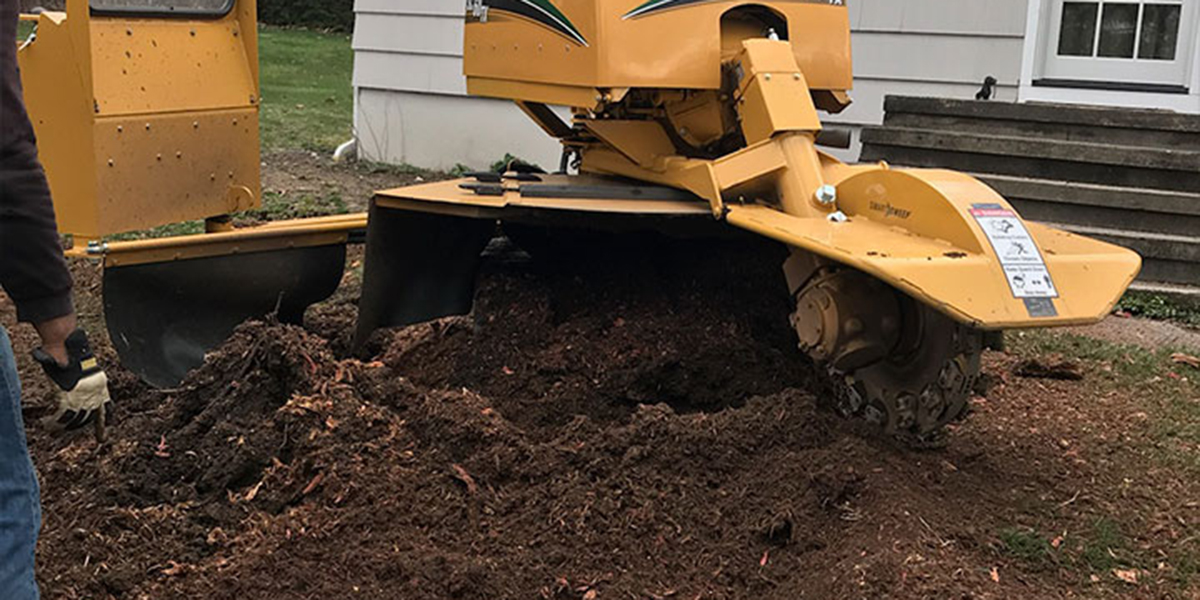After removing a tree from your yard and hiring a tree service in Naugatuck, CT, to grind the stump, you’re left with a clean patch of ground. However, when you realize that stump grinding only removes the visible remnants of the tree and the first few inches of roots, you might wonder what to expect from the roots that remain underground. Many homeowners ask: “Do tree roots die after stump grinding?”
It’s a fair question, but the good news is that you don’t need to worry about the underground root system.

What Stump Grinding Does to the Roots
Stump grinding effectively removes what’s left after you take down a tree. Using a powerful grinder, professionals turn the stump into wood chips. The grinder also pulverizes the root system up to a foot below ground level.
This process removes the part of the tree you can see, but it doesn’t pull up the entire root system. That’s why the question, “Do tree roots die after stump grinding?” is so important. Unlike stump removal (which pulls up the stump and roots together), stump grinding leaves the roots behind. Although they typically decay naturally over time, homeowners often worry that the roots will send up new shoots or cause other landscaping problems.
Do Roots Die After Stump Removal vs. Grinding?
When you opt for stump removal, the tree service digs out and completely removes the stump and root ball. Because the roots are gone, they stop growing immediately.
Stump grinding leaves the roots underground, and they don’t just disappear overnight. Depending on the size of the tree, the roots may take several years to decompose fully.
Tree Root Growth After Stump Grinding
One of the biggest concerns homeowners have is whether the roots will continue to grow after stump grinding. The good news? In most cases, this doesn’t happen because, without leaves to provide them with energy through photosynthesis, the roots can’t keep growing indefinitely.
However, some tree species with aggressive root systems, such as maples and willows, see short-term sprouting from the leftover roots. This is usually temporary. With time (and sometimes extra mowing or applying herbicide), the root system eventually stops trying to regenerate.
Stump grinding can have additional effects on tree roots. As the roots decompose, the ground above may sink slightly; however, you can settle the destabilized earth with a layer of topsoil and grass seed. Root decomposition actually helps enrich the soil, creating a healthier environment for new landscaping.
So, while you might worry about what’s happening underground in the short term, the long-term effects are usually positive.
Call the Experts at GM 2 Tree Service for Professional Stump Grinding and Root Care in Naugatuck, CT
For most homeowners, stump grinding is a practical and cost-effective way to deal with unwanted stumps. But understanding what happens after the grinder leaves your driveway can help you plan your next steps, whether they involve replanting, reseeding, or simply letting nature take its course.
If you’re still wondering, “Do tree roots die after stump grinding?” the short answer is yes, but it takes time. The roots left behind won’t cause damage in most cases, and they’ll eventually return their nutrients to the soil.
Do you have questions about stump grinding and root care? Need a stump grinding vs. stump removal guide? Or maybe you’re finally ready to get rid of that stubborn stump in your yard? GM 2 Tree Service has the tools and experience to handle it all. Call us today at (860) 940-5783 to schedule your stump grinding in Naugatuck, CT.
